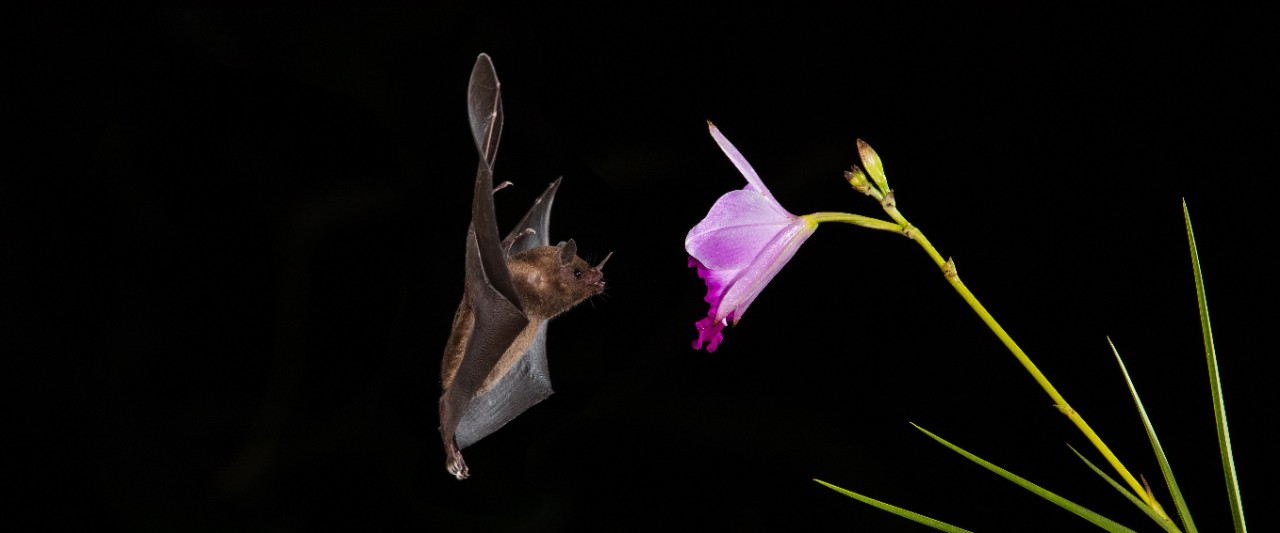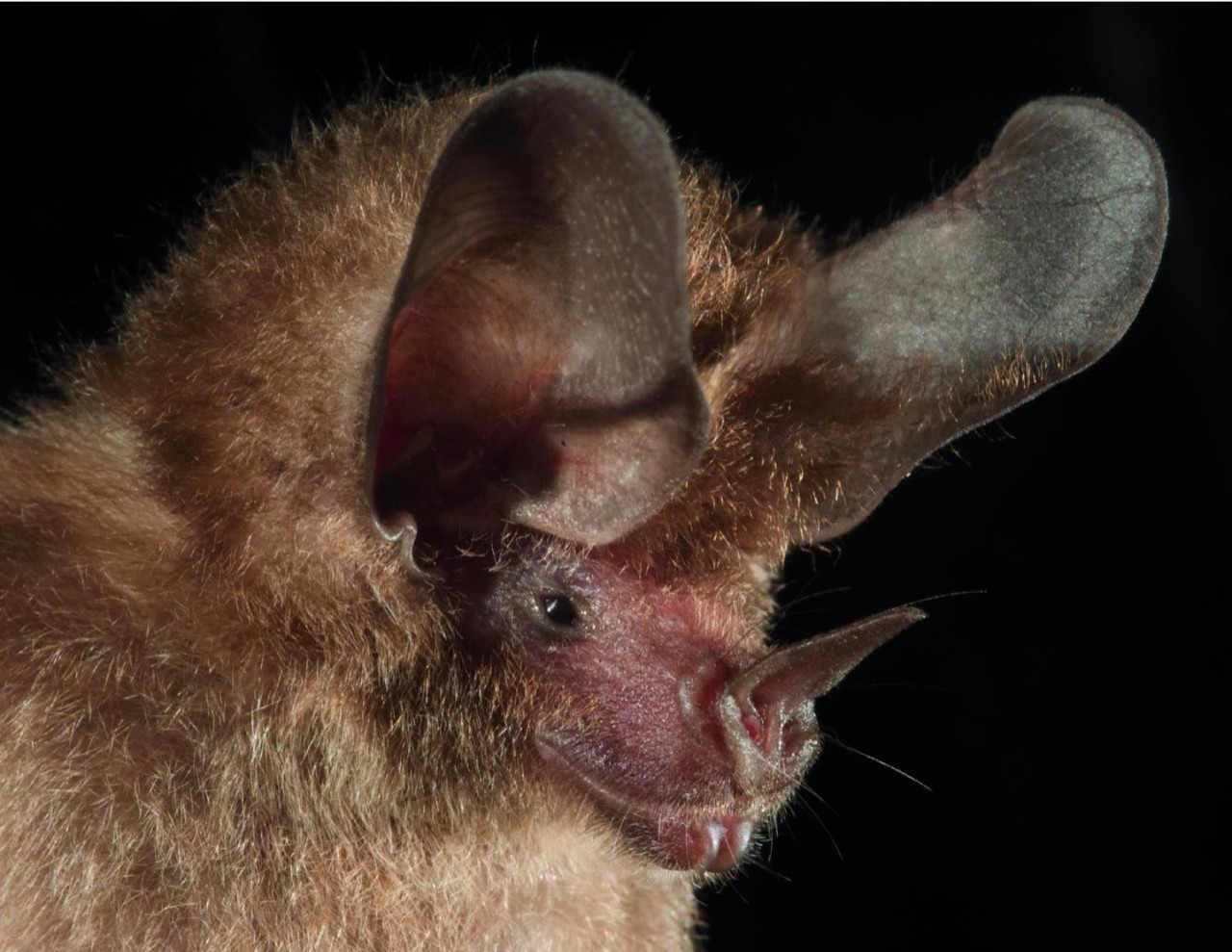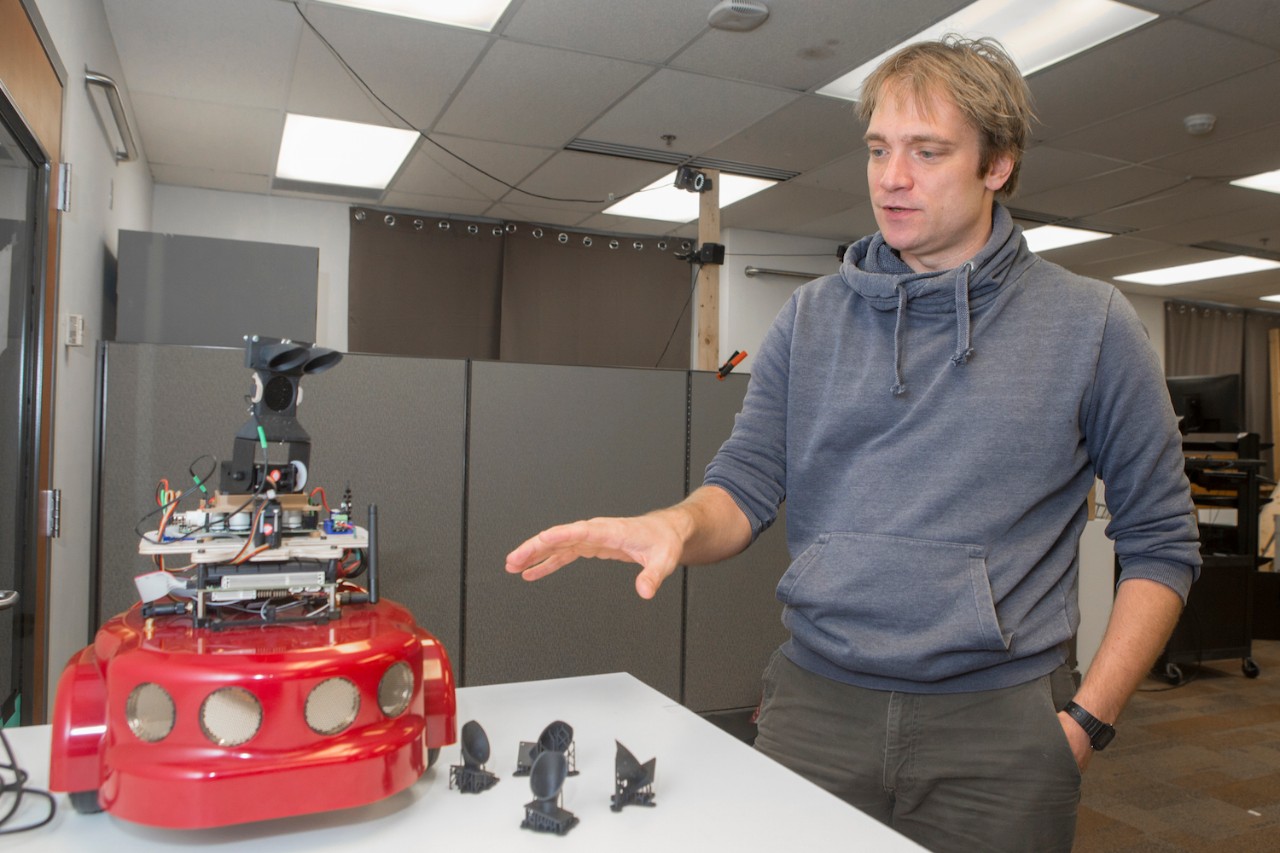
Bats bounce sound off leaves to find hidden prey
University of Cincinnati research found that bats can tell an insect from a leaf using sound alone
Most insects use camouflage to hide in plain sight from predators.
But an international research team found that some bats thwart this defense by finding insects on leaves or branches using sound alone. The discovery was published in the journal Current Biology.
University of Cincinnati biologist Dieter Vanderelst helped unlock the superpowers of the common big-eared bat, a tiny species found across South America, including a jungle island outside the Panama Canal. Barro Colorado Island is off-limits to visitors but serves as a research station for biologists and conservationists.
Researchers captured wild bats from a known day roost in a storm drain. They set up high-speed cameras and an array of audio sensors in a flight cage to observe how the little predators can find insects hidden among the leaves in total darkness.

A common big-eared bat. Photo/Elizabeth Clare/EurekAlert!
Most bats use echolocation to find moths or mosquitoes buzzing in the open air. But Vanderelst said the big-eared bats have refined this skill into a superpower.
“These bats do something that’s difficult for echolocation. They take prey right off branches and leaves that return an echo much louder than the signal you’re looking for,” Vanderelst said.
The study demonstrates UC's commitment to research as described in its strategic direction, Next Lives Here.
An infrared camera captures a big-eared bat scanning a leaf in complete darkness to find a perched dragonfly. The leaf is studded with acoustical sensors. Video/ChiRoPing Consortium
The bats have a leaf-shaped appendage on their nose that helps them aim and focus their high-frequency chirps to scan their complex environment. And true to their name, big-eared bats have big ears in proportion to their bodies to capture the echo.
“They’re special in a sense because they’ve pushed their adaptations even farther,” he said. “They have very directional hearing. Their ears are huge. And they use very high frequency sounds compared to other bats. That allows them to have good time resolution.”
Vanderelst is an assistant professor of biology, psychology and electrical and mechanical engineering in UC’s McMicken College of Arts and Sciences and its College of Engineering and Applied Science. For some of his projects, he has taken cues from bats to improve autonomous drone navigation.
Previously it was thought to be a sensory impossibility to find silent and motionless insects resting on leaves just by using echolocation.
Inga Geipel, Smithsonian Tropical Research Institute
Researchers conducted experiments in a concrete bunker in the rainforest to block out ambient light. They taped a dead dragonfly to a leaf dotted with 20 microphones in a tiny bat flight cage. Then they used high-speed cameras to capture the graceful and precise navigational aerobatics of the bats as they hunted prey.
Field research in the tropics poses unique challenges. High humidity fogs camera lenses. The extreme isolation of the island meant long waits to repair or replace equipment. Four of five researchers sat for long periods in a cramped, hot and foul-smelling room shared by lots of spiders.
“It’s a nightmare scenario. You have to be a special kind of person to want to do that,” he said.

UC assistant professor Dieter Vanderelst talks about his Panama research in his office during summer break. Photo/Joseph Fuqua II/UC Creative Services
Big-eared bats are unusual among bats, said Inga Geipel, the study’s lead author and a fellow with the Smithsonian Tropical Research Institute. They specialize in hunting comparatively larger prey such as dragonflies and lizards. And they bring insects back to their babies for as long as five months after their pups are weaned
“I have been working with this species for over 12 years now and they surprise me over and over again,” Geipel said.
Geipel first observed the bat’s amazing echolocation in a 2013 study. For the latest paper, researchers tried to understand how they manage this feat.
“Previously it was thought to be a sensory impossibility to find silent and motionless insects resting on leaves just by using echolocation as the weaker prey echoes would be masked by the stronger echoes of the leaves,” Geipel said.
The little bats can hover like a hummingbird as they scan their environment. High-speed video revealed how the bats approach the target leaf from below and gradually ascend like a drone rising over a tree. They had no trouble finding the meal, plucking the tasty insect from the leaf and carrying it off to devour.
The high-frequency bat chirps strike the leaf’s surface at different angles. The pulses deflect off the leaf and bounce off the unwitting prey, reflecting back an echo to the bats that something besides the leaf is there. Scientists call this “specular reflection.”
“We found that the bat approached the insects in a stereotypical way, coming up from the ground,” he said. “And it uses the mirror effect. When you call against a flat surface, most of the echo bounces away from you. But if there is an insect there, it creates a reflector and you start to get an echo back. It’s an adaptive behavior to separate the background, which is conspicuous, from the prey.”

Staff with the Cincinnati Museum Center hold a bat during a presentation to high school students during UC's new Biology meets Engineering summer program. Photo/Andrew Higley/UC Creative Services
Researchers replicated the bat’s hunting strategy using sensors and artificial sonar to measure the energy returning from leaves at different angles. Indeed, the tests showed a discernible change in echo when an insect was present on the leaf.
Geipel said the bat’s refined echolocation even can help them distinguish types of prey. Experiments showed how the bats could distinguish between real dragonflies and dragonfly-shaped dummies made of paper and aluminum, she said.
The big-eared bat’s extraordinary echolocation opens up new hunting opportunities for them, Vanderelst said.
“It allows them to exploit a completely different niche,” Vanderelst said. “Most bats like to stay away from vegetation while hunting. Some bats will wait for the flying insect to take off and become conspicuous. Others will stop echolocating and listen for the sounds generated by the insects.”

UC assistant professor Dieter Vanderelst has applied cues from nature to robotics and other engineering applications. Photo/Joseph Fuqua II/UC Creative Services
Bats and their prey are in a never-ending arms race. Some moths are covered in sound-dampening scales to reduce their acoustic footprint like a stealth fighter. Others have evolved to freeze in midair and drop like a stone when they hear a bat nearby. Still others can emit their own high-frequency sounds to disrupt bat calls, effectively jamming the sonar. And bats have responded, evolutionarily speaking, by calling more quietly to detect moths without alerting them to their presence, Vanderelst said.
Many plants have developed a relationship with nectar-eating bats who serve as their primary pollinators. Scientists long puzzled over why some flowers had unusual bowl-shaped leaves next to their blossoms until they realized they provided a sound-reflecting signal to help bats find the delicious blooms in the dark.
Yes, a bat signal.
“It’s a wonder that biologists missed that for so long,” Vanderelst said. “Now it’s obvious what the leaf is for.”
Researchers still don’t know just how good bats are at identifying individual prey by sound. Vanderelst said he isn’t convinced the bats have refined their abilities to the point where they can tell a tasty insect from a toxic one, for example.
“Some people think bats build a highly detailed image of what the insect looks like on the leaf,” he said. “But I think what is happening is much simpler. It sees if there’s something there to eat. If there is, I’ll chew it. And if it doesn’t taste good, I’ll spit it out.”
The experiments took place in a simple environment with few navigational obstacles or distractions. Vanderelst said he would like to know more about how bats hunt prey in a vastly more complex rainforest.
And the research opens up more questions about the secret abilities of animals and how they might translate to engineering.
“I’ve always been interested in what animals perceive. What does a spider see? What does a dog smell? If I were a snake, how would the world be different?” he said. “You can look at it from a technical or biological point of view.”
Featured image at top: A nectar-drinking bat uses echolocation to find a flower. Species such as the common big-eared bat can use sound to tell insects from leaves. Photo/Zdeněk Macháček/Unsplash

UC assistant professor Dieter Vanderelst uses cues from nature to improve technology. Here he shows off an autonomous robot that uses echolocation to navigate like a bat. Photo/Joseph Fuqua II/UC Creative Services
Next Lives Here
Discover UC's commitment to Next Lives Here, the strategic direction with designs on leading urban public universities into a new era of innovation and impact.
Become a Bearcat
Do you like the idea of conducting your own biology research? Apply online or get more information about undergraduate enrollment by calling 513-556-1100. Learn more about UC's many undergraduate and graduate programs.
Related Stories
Bearcats Racing speeds toward a victorious season
April 12, 2025
Bearcats Motorsports, Bearcats Baja and Bearcats EV are racing to build winning car models at UC’s 1819 Innovation Hub as competition season approaches.
CEAS Expo unveils inaugural innovation awards – discover the...
April 11, 2025
During the CEAS Expo’s first-ever 1819 Innovation Awards, five groundbreaking inventions received recognition. Learn about prize winners from the CEAS Expo and their transformative projects.
What is Biology?
April 10, 2025
Biologists' work impact life every day. From disease research and medical enhancements to protecting ecosystems across the planet, the work of biologists is needed to improve the world. And majoring in biological sciences within UC’s College of Arts and Science will allow you to gain a perspective that focuses on the betterment of the world around you. Spanning from different topics like molecular and cell studies to conservation efforts, there’s is something for everyone.
